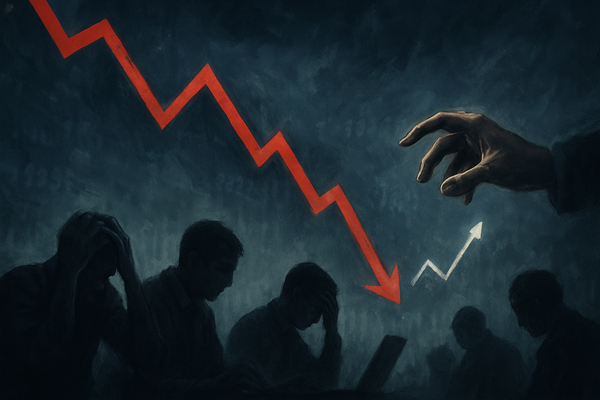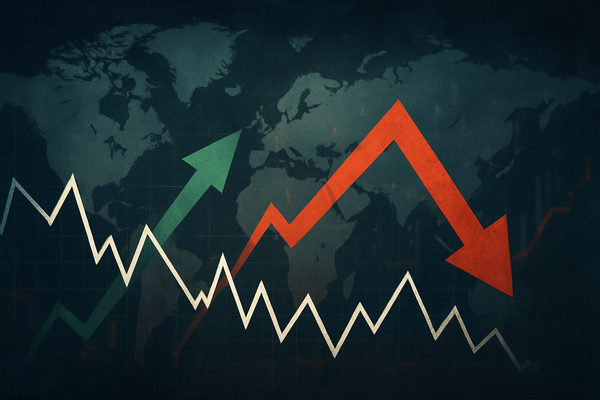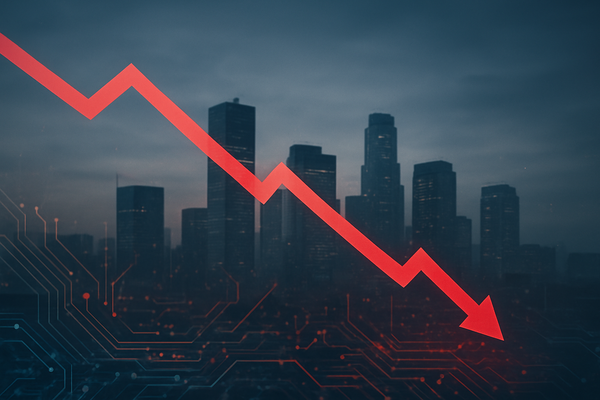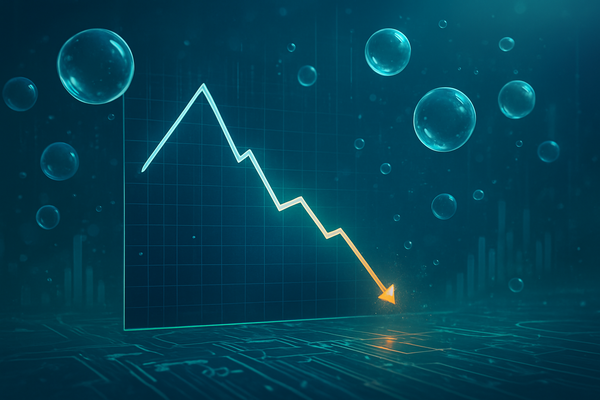Gold and Silver Retreat on MCX as Resurgent U.S. Dollar Flexes Its Might
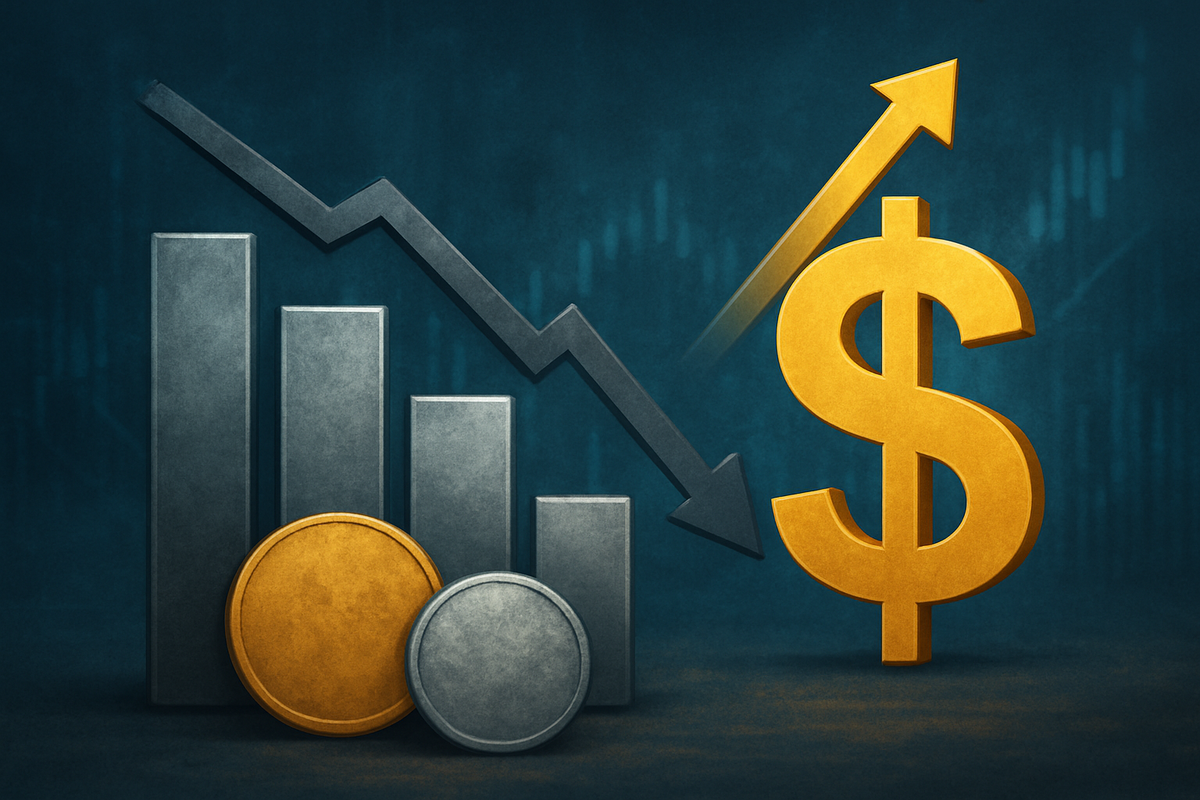
Mumbai, India – October 31, 2025 – Precious metals, gold and silver, are experiencing a notable easing on India's Multi Commodity Exchange (MCX) today, as a formidable strengthening of the U.S. dollar takes center stage in global financial markets. This downturn underscores the classic inverse relationship between the world's reserve currency and dollar-denominated commodities, making bullion less attractive for international investors and signaling a shift in investor sentiment.
The current market dynamics see investors pivoting away from traditional safe-haven assets like gold and silver, drawn instead to the bolstered appeal of the U.S. dollar. This movement is not merely a fleeting trend but a reflection of deeper economic signals, including the U.S. Federal Reserve's cautious monetary policy outlook, which is providing significant tailwinds for the greenback and consequently exerting downward pressure on the price of bullion.
Dollar's Ascent Dents Bullion's Luster
The retreat in gold and silver prices on the MCX on October 31, 2025, is a direct consequence of a robust U.S. dollar, which is trading near a three-month high. Gold futures for December delivery on the MCX opened lower, declining 0.29% to Rs 1,21,148 per 10 grams, following a close of Rs 1,21,508 the previous day. Silver futures mirrored this trend, opening 0.47% down at Rs 1,48,140 per kg. By midday, both metals continued their decline, with gold falling around 0.25% to Rs 1,21,200 per 10 grams and silver decreasing by over half a percent. This downward pressure is attributed to a combination of profit-taking by traders and the anticipation of crucial U.S. economic data releases. Earlier in the week, on October 27, MCX gold futures had already fallen by 0.78% to ₹1,22,490 per 10 grams, and silver futures declined by 1.07% to ₹1,45,898 per kilogram.
The timeline leading to the dollar's current strength is marked by key policy decisions and economic indicators. The U.S. Federal Reserve's October 29, 2025, decision to cut interest rates by 25 basis points, bringing the benchmark rate to 3.75%-4.00%, was accompanied by cautious commentary from Fed Chair Jerome Powell regarding future easing. This uncertainty was interpreted as a hawkish signal by the market, tempering optimism in the bullion sector and making the dollar a more appealing investment vehicle. Resilient U.S. economic data, such as stronger-than-expected non-farm payrolls earlier in June 2025, has also played a crucial role in enhancing the dollar's valuation. Furthermore, improved global sentiment, including positive developments in U.S.-China trade talks, has reduced the traditional safe-haven demand for gold, further bolstering the dollar's position.
Key players in this scenario include the U.S. Federal Reserve, whose monetary policy decisions directly influence currency strength and, by extension, commodity prices. Major central banks globally also play a role through their own monetary policies, which can affect relative currency strengths. On the MCX, traders and institutional investors are the immediate stakeholders reacting to these global cues. Initial market reactions have seen a clear shift from non-yielding assets like gold and silver towards interest-bearing dollar assets, highlighting a renewed confidence in the U.S. economy and its currency. Despite the recent dip, gold had been on a spectacular rally throughout 2025, reaching an all-time high near $4,381.58 earlier in the year and aggressively testing the $4,000 per ounce barrier on October 30, 2025, indicating that the current easing might be a short-term correction within a broader bullish trend for the metal. Spot gold internationally fell 0.5% to $4,004 per ounce on October 31.
Corporate Fortunes Shift: Miners Brace for Headwinds, Jewelers See Sparkle
The current macroeconomic environment, characterized by easing gold and silver prices and a strengthening U.S. dollar, is creating a distinct divergence in fortunes across various industries. While precious metal miners are bracing for challenging times, jewelry retailers are poised to benefit from reduced input costs, and the impact on investment firms remains highly dependent on their strategic positioning.
Gold and silver mining companies are undoubtedly among the primary losers in this scenario. As the price of their core products declines, their revenue per ounce sold directly diminishes, leading to significant pressure on profit margins. Companies with higher "all-in sustaining costs" (AISC) per ounce will feel the squeeze most acutely, potentially leading to operational cutbacks, deferred exploration projects, or even the temporary closure of marginal mines. The strengthening U.S. dollar further compounds this challenge; since gold and silver are dollar-denominated, a stronger dollar makes them more expensive for international buyers using other currencies, potentially dampening global demand. Major players such as Newmont Corporation (NYSE: NEM), Barrick Gold Corporation (NYSE: GOLD), and silver-focused miners like Pan American Silver Corp. (NASDAQ: PAAS) and First Majestic Silver Corp. (NYSE: AG) are likely to see their stock performance pressured as investor capital rotates out of precious metals. Their operational strategies will likely shift towards stringent cost control and optimizing production from higher-grade, lower-cost assets.
Conversely, jewelry retailers are positioned as significant beneficiaries. The easing prices of gold and silver translate directly into lower raw material costs, effectively reducing their cost of goods sold. A strong U.S. dollar further amplifies this advantage, making imported finished jewelry or raw materials cheaper for retailers operating in dollar-denominated markets. This improvement in input costs can significantly boost profit margins and, by extension, their overall profitability. Furthermore, lower retail prices for jewelry, stemming from cheaper raw materials, can stimulate consumer demand, making fine jewelry more accessible and attractive to a broader market, potentially driving higher sales volumes. Companies like Signet Jewelers Limited (NYSE: SIG), the parent company of popular brands like Kay Jewelers and Zales, and luxury conglomerates such as LVMH Moët Hennessy Louis Vuitton (EPA: MC), which owns Tiffany & Co. and Bulgari, stand to gain from these favorable market conditions. Their operational strategies may involve adjusting pricing to be more competitive, managing inventory efficiently, and exploring new product lines that leverage the lower cost of precious metals.
For investment firms, the impact is more nuanced, creating both winners and losers depending on their specific mandates and asset allocations. Firms with substantial long-only exposure to gold and silver, or those managing commodity-focused funds such as the iShares Silver Trust (NYSEARCA: SLV) or the VanEck Junior Gold Miners ETF (NYSEARCA: GDXJ), are likely to experience a decrease in assets under management (AUM) and performance fees as metal prices fall. On the other hand, investment firms that have diversified portfolios, are strategically positioned for a strong dollar, or have taken short positions on precious metals could see gains. Funds focused on U.S. domestic equities or U.S. fixed income, which offer attractive yields in a strong dollar environment, are also likely to perform well. For instance, a fund like the Invesco DB U.S. Dollar Index Bullish Fund (NYSEARCA: UUP) would likely benefit from the strengthening greenback. Investment firms will need to reassess asset allocation strategies, potentially reducing exposure to precious metals and increasing allocations to U.S. domestic assets or other sectors that benefit from current macroeconomic trends, with currency risk management becoming a paramount concern.
Wider Significance: A Dollar-Driven Reset in Global Markets
The easing of gold and silver prices, primarily driven by a strengthening U.S. dollar, signals a broader recalibration within global financial markets, reflecting shifts in central bank policies, economic outlooks, and investor sentiment. This dynamic is not merely a short-term fluctuation but fits into a larger narrative of "U.S. exceptionalism" and a cautious global economic landscape.
The current environment is deeply intertwined with the monetary policies of major central banks. As of October 31, 2025, the U.S. Federal Reserve's cautious stance following a recent 25 basis point interest rate cut, coupled with Chairman Powell's uncertain remarks about further easing, has solidified expectations for a potentially "higher-for-longer" interest rate environment in the U.S. This contrasts with other major central banks, such as the European Central Bank (ECB), which kept its rates unchanged on October 30, 2025, and is generally anticipated to pursue a more gradual easing path in 2025. These diverging monetary policies attract capital flows into dollar-denominated assets, bolstering the greenback's strength. The global economic outlook for 2025, projecting modest growth rates of 2.9% to 3.2%, combined with new U.S. trade policies and higher tariffs, adds layers of uncertainty, making the perceived stability of the U.S. dollar even more appealing.
This dollar-driven precious metal pullback, while significant, is viewed by many as a short-term correction following a spectacular rally earlier in the year, which saw gold reach an all-time high of over $4,380 per ounce internationally on October 20, 2025. The easing is attributed to profit-taking, a reduction in geopolitical tensions (particularly positive developments in U.S.-China trade discussions), and a normalization in the silver market. Despite these headwinds, the long-term outlook for precious metals remains generally constructive due to underlying trends like record central bank gold accumulation, exceeding 1,000 tonnes annually since 2022. This institutional demand provides a fundamental floor for gold, as central banks continue to diversify their reserves away from a sole reliance on the U.S. dollar. Silver's dual role as an industrial metal also means its demand is supported by the booming renewable energy sector, especially solar energy.
The ripple effects of a strong dollar and easing precious metal prices extend across various market participants. For investors seeking safe havens, a robust U.S. dollar, offering attractive yields through U.S. Treasuries, directly competes with gold and silver, potentially diverting investment flows. Within the precious metals sector, mining companies face significant pressure, with large-cap miners experiencing declines of 15-20% in their stock valuations during recent corrections, and smaller producers facing even greater challenges due to their leverage to commodity prices. Conversely, jewelers and industrial users outside the U.S. will find gold and silver more expensive in their local currencies, potentially impacting demand, though a price dip can temporarily stimulate consumer interest in markets like India. Regulatory and policy implications include central banks closely monitoring inflation and employment data for future monetary policy adjustments, while easing trade tensions reduce the "fear premium" often embedded in gold prices. The long-term trend of central bank diversification into gold also represents a strategic shift to reduce reliance on the dollar as the primary reserve currency, a policy decision with profound global implications.
Historically, the inverse relationship between the U.S. dollar and precious metals has been observed repeatedly. During the early 1980s, aggressive Federal Reserve rate hikes led to a strong dollar and a sharp decline in gold prices. Similarly, the late 1990s saw gold reach a low amidst a strong U.S. economy and dollar. Conversely, periods of dollar weakness, such as during the 2008 financial crisis, often coincide with soaring gold prices as investors flock to safe-haven assets. However, it's crucial to note that this relationship isn't always linear; since 2010, there have been instances where both gold and the dollar moved higher simultaneously, particularly during times of intense global financial instability or high inflation concerns. The ongoing central bank buying and persistent geopolitical uncertainties suggest that while a strong dollar presents a significant headwind, these other factors may provide a crucial underlying support for precious metals, preventing a complete collapse in prices.
What Comes Next: Navigating Volatility and Long-Term Trends
The immediate future for gold, silver, and the U.S. dollar is likely to be characterized by continued volatility, but underlying long-term trends suggest a complex and potentially rewarding landscape for strategic investors. While the strengthening dollar may exert short-term pressure, fundamental drivers for precious metals are expected to reassert themselves.
In the short term, over the coming months, gold and silver may experience further corrections. Gold, having recently cooled from its all-time high of over $4,380 per ounce internationally, could potentially target levels around $3,500 if profit-taking continues and the U.S. dollar maintains its strength, especially with the Federal Reserve's cautious stance on aggressive rate cuts. Silver, after touching nominal highs near $54.50, might also see a consolidation or a pullback towards $40 before its next significant upward move. The U.S. dollar, currently robust with the DXY near 99.64, is expected to remain firm in the near term, supported by resilient U.S. economic data and tempered expectations for rapid Fed easing.
Looking further ahead, into 2026 and beyond, the long-term outlook for gold and silver remains largely bullish. Gold is projected to reach new highs, with some forecasts suggesting $4,000 by mid-2026 and even ambitious targets of $8,000 by 2028. This optimism is fueled by persistent central bank gold accumulation, which has consistently exceeded 1,000 tonnes annually since 2022, signifying a global trend towards diversification away from dollar reliance. Furthermore, sticky inflation and ongoing geopolitical tensions are expected to sustain gold's appeal as a safe haven. Silver's long-term trajectory is even more compelling due to its dual role: strong industrial demand from burgeoning sectors like electric vehicles (EVs), solar panels, and 5G technology is expected to create supply deficits, while its traditional appeal as a precious metal will see it follow gold's upward momentum. Forecasts for silver range widely, but many anticipate it climbing to $70-$100 by 2026-2027 and potentially much higher in the longer term. The U.S. dollar's long-term path is less clear-cut; while short-term strength persists, a projected easing cycle by the Federal Reserve in late 2025 and into 2026 could lead to a weaker dollar, making precious metals more attractive. However, concerns over U.S. debt and de-dollarization trends could introduce further volatility, even as its safe-haven status provides occasional support.
Market participants will need to adapt strategically. Investors are advised to consider re-evaluating their portfolios, potentially maintaining a diversified allocation of 5-20% in precious metals as a hedge against systemic risks. Price corrections in gold and silver should be viewed as potential buying opportunities for long-term holders. Miners will need to prioritize cost efficiency and explore hedging strategies to navigate fluctuating prices, while industrial users of silver should focus on securing long-term supply contracts. Emerging markets, particularly India and China, will continue to be significant drivers of demand for both gold jewelry and industrial silver. However, challenges such as market volatility, the impact of a strong U.S. dollar on international purchasing power, and potential technological substitution for silver will require careful monitoring. Potential scenarios range from moderate global growth leading to gradual precious metal gains, to persistent high inflation or a global recession, either of which could trigger significant rallies in gold and silver as investors seek refuge from economic uncertainty and currency debasement.
Comprehensive Wrap-Up: A Resilient Future for Bullion Amidst Currency Shifts
The current easing of gold and silver prices on the MCX, largely driven by a strengthening U.S. dollar, serves as a timely reminder of the intricate dance between currency dynamics and commodity markets. While the immediate impact is a period of correction for precious metals and challenges for mining companies, the broader picture reveals a resilient future for bullion, underpinned by robust fundamental drivers and evolving global financial architecture.
Key takeaways from this event highlight the Federal Reserve's pivotal role in shaping global currency strength and, by extension, commodity valuations. The dollar's current ascent, fueled by cautious Fed policy and U.S. economic resilience, has temporarily diminished the safe-haven appeal of gold and silver. However, this short-term pressure is occurring within a larger context where central banks globally are actively diversifying their reserves with gold, signaling a long-term strategic shift away from an over-reliance on the U.S. dollar. This institutional demand, coupled with persistent inflation concerns and silver's burgeoning industrial applications in green technologies, provides a strong structural foundation for precious metals.
Moving forward, the market will remain highly sensitive to central bank pronouncements, particularly from the Federal Reserve, regarding interest rate policy. Any dovish pivots or indications of aggressive easing could swiftly reverse the dollar's strength and provide significant tailwinds for gold and silver. Investors should also closely monitor global inflation data and geopolitical developments, as these factors will continue to influence safe-haven demand. While the U.S. dollar is currently flexing its might, its long-term trajectory faces challenges from rising U.S. debt and global de-dollarization efforts, suggesting that its dominance, while currently firm, may evolve.
In the coming months, investors should watch for sustained central bank buying reports, which could signal underlying strength for gold. For silver, attention should be paid to industrial demand indicators, especially from the renewable energy sector, which will be crucial for its price performance. While short-term volatility is expected, the fundamental case for including precious metals in a diversified portfolio as a hedge against systemic risks, currency debasement, and inflation remains compelling. The current dip may, for many, represent a strategic entry point into assets with a strong long-term outlook.
This content is intended for informational purposes only and is not financial advice
